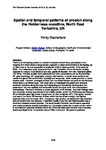Spatial and temporal patterns of erosion along the Holderness coastline, North East Yorkshire, UK
| dc.contributor.author | Macfarlane, V. | |
| dc.date.accessioned | 2019-05-15T13:54:35Z | |
| dc.date.available | 2019-05-15T13:54:35Z | |
| dc.date.issued | 2012 | |
| dc.identifier.citation |
Macfarlane, V. (2012) 'Spatial and temporal patterns of erosion along the Holderness coastline, North East Yorkshire, UK', The Plymouth Student Scientist, 5(2), p. 330-388. | en_US |
| dc.identifier.issn | 1754-2383 | |
| dc.identifier.uri | http://hdl.handle.net/10026.1/13995 | |
| dc.description.abstract |
There is an increasing problem of erosion in coastal environments, particularly in soft material cliffs which need to be protected; migration to these environments is increasing, up to 75% more of the total population is predicted to live in close proximity to the coast by 2020. The Holderness coast (located in North East Yorkshire, UK) is the fastest eroding coastline in Europe. It comprises of soft clay, glacial till deposits from the Devensian period (18-13Ka). Previous studies have calculated that many parameters such as till properties, cliff geomorphology, cliff topography, strength and reaction to varied water contents are varied throughout this environment, spatially and temporally, which would give rise to varied erosion rates. However, averaged retreats from the whole location are given in the literature, which lacks a combined study. This study aims to investigate the spatial and temporal erosional variations along the coast by investigating and correlating trending data from parameters that vary spatially and temporally across the study area, with standardised methodology. The use of sinuosity is a new approach in cliff erosion. The main findings were that the lowest erosion was located in the middle section, where the Withernsea and Skipsea till combination gave high shear strength and formed the highest cliffs. The highest erosion rate was in the south, Withernsea till area, which had low shear strength, the highest plasticity index and the lowest cliffs. Throughout, high erosion correlated with high sinuosity and low erosion with low sinuosity. Predictive models imply that the middle location has a dominant subaerial erosion process. The south location however has the same subaerial and marine erosional process intensities, but the erosion varies due to water content which is controlled by seasonal variation; this effect differs between each location due to varying plastic and liquid limits. A maximum loss of 208m in the next 100 years is predicted. | en_US |
| dc.language.iso | en | en_US |
| dc.publisher | University of Plymouth | |
| dc.rights | Attribution 3.0 United States | * |
| dc.rights.uri | http://creativecommons.org/licenses/by/3.0/us/ | * |
| dc.subject | coastal environments | en_US |
| dc.subject | soft material cliffs | en_US |
| dc.subject | Holderness coast | en_US |
| dc.subject | North East Yorkshire, UK | en_US |
| dc.subject | Europe | en_US |
| dc.subject | cliff geomorphology | en_US |
| dc.subject | cliff topography | en_US |
| dc.subject | Withernsea till area | en_US |
| dc.title | Spatial and temporal patterns of erosion along the Holderness coastline, North East Yorkshire, UK | en_US |
| dc.type | Article | |
| plymouth.issue | 2 | |
| plymouth.volume | 5 | |
| plymouth.journal | The Plymouth Student Scientist |



